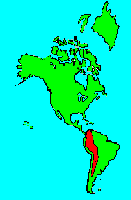SPECIES INFO
Sapphire quail-dove (Geotrygon saphirina) is found in the central and eastern Andes from central Colombia south to Bolivia. This 9 inch quail-dove is very distinctive. The face is white with a black or gray cap. There is a black band across the lower face. The upper breast is gray, and the lower breast is white. The dorsal wings are chestnut.
The image in Goodwin shows a rather small quail like bird with a white neck and belly. The dorsal wings are brown. There is a black band from the base of the bill to the blue cap.
There are three subspecies. The nominate subspecies is found from eastern Ecuador to south eastern Peru and further south to northern Bolivia. This is also found in the western Amazon Valley. The subspecies purpurata is found from northwestern Colombia to northwestern Ecuador. The subspecies rothschildi is local found only in the Marcapata Valley of south eastern Peru.The New World Quail-Dove genus (Geotrygon) is found from Mexico and the Caribbean south to northern Argentina and northern Bolivia. There are about 16 species depending upon how some subspecies are treated. These species generally are found on or near the ground in rain forest areas. Most species are between 9 and 14 inches in length. Although most have dull coloration, some species have heads that are very colorful. The tail tips are not white.
In 1983 in Goodwin three of the current species were listed as subspecies as follows:
Geotrygon lawrencii carrikeri to Geotrygon carrikeri
Geotrygon linearis albifacies to Geotrygon albifacies
Geotrygon linearis chiriquensis to Geotrygon chiriquensis
With over three hundred species in the pigeon and dove family (Columbidae) found world wide, we have broken this family into two parts based on geographical origin with the Old World versus the New World as the criteria. This is the New World portion.
Pigeon and Dove group (Family Columbidae) are a group of about 290 species of birds that are found worldwide.
Pigeons and Doves (Order Columbiformes) contains three families. The dodos (Family Raphidae) are extinct. The other families are the sandgrouse (Family Pteroclidae) and pigeons (Family Columbidae).
Clements in 2007 counted 308 pigeons and doves and Clements also counted 16 sandgrouse. (He, however, placed the sandgrouse in their separate order, Pterocliformes.)
Aves contains about 8,650 different species of living birds known to science. Each year about one new species is discovered in some remote rain forest or remote island. In addition, scientists have been raising many subspecies to full species status which may raise the species count to 10,000. Birdlife recognizes 10,027 species as of 2011.
However, each year about one species goes extinct. The rate of extinction is increasing, and the rate of new discovery is decreasing, so that the number of bird species will soon begin to decline rapidly. Although different taxonomists would organize the birds differently, there are approximately twenty-seven orders of birds. These orders are broken down into about one hundred and fifty-five different families.
Recent research of the genetic structure of some of the shore birds and owls would indicate that the present organization of orders and families should have some modification.
The birds are a worldwide group of animals that are characterized by having the front limbs modified into wings that are used for flying. Perhaps the most unique feature of the birds is the feathers. These feathers are made up of a central support called a quill and a series of small filaments that are hooked together as barbs.
For many years it was believed that Archaeopteryx discovered in Bavaria was the oldest bird from about 150 million years ago. However, in l986, Sankar Chattterjee, a Texas paleontologist, reportedly discovered a bird in the genus Protoavis that lived about 225 million years ago.
When this project was begun in 1978, we used Austin & Singer for bird taxonomy. Since then, we have adopted many changes, but have kept some older concepts that are still found widely in the literature. Recently, we have used Clements and Howard & Moore. Very recently, we have used Monroe and Sibley for the higher taxonomy of the perching birds.
Backboned Animals (Phylum Chordata) are the most advanced group of animals on earth. These animals are characterized by having a spinal cord or backbone. Most members have a clearly defined brain that controls the organism through a spinal cord. Fish, amphibians, reptiles, birds, and mammals are in this phylum.
Currently, some taxonomists believe that the fish should be divided into two groups (sharks and regular fishes) and that there are some other primitive groups in the phylum such as hagfish or lampreys.
Animal Kingdom contains numerous organisms that feed on other animals or plants. Included in the animal kingdom are the lower marine invertebrates such as sponges and corals, the jointed legged animals such as insects and spiders, and the backboned animals such as fish, amphibians, reptiles, birds, and mammals.

